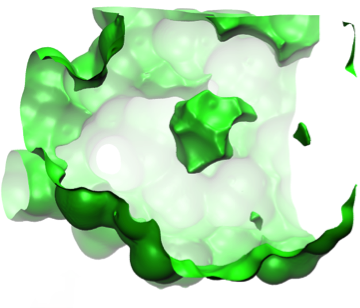A pinch of salt in ONETEP's solvent model
eCSE001-004Key Personnel
PI: Chris-Kriton Skylaris - The University of Southampton
Technical: Lucian Anton and Jacek Dziedzic - STFC
Relevant Documents
Technical Report: A pinch of salt in ONETEP's solvent model
Project summary
Chemical reactions, drug-protein interactions, and many chemical and physical processes on surfaces are examples of technologically important processes that happen in the presence of solvents. The inclusion of electrolytes (salt) in solvents such as water is crucial for biomolecular simulations, as most processes (e.g. protein-protein or protein-drug interactions or DNA mutations) take place in saline solutions. In this project we aimed to develop the capability to model electrolyte-containing solvents in quantum-mechanical simulations of materials from first principles.
The above aim has been achieved by extending the functionality and performance of two existing computer codes in tandem - the DL_MG multigrid solver and the ONETEP linear-scaling density functional theory package. The modifications to DL_MG were extensive in scope and included implementing an inexact-Newton solver, revisions in the treatment of boundary conditions, with simultaneous careful consideration of numerical stability in the presence of severe nonlinearities, and with continued excellent parallel performance in mind. Modifications to ONETEP involved comparatively less implementation, with significant focus on the physically correct capturing of relevant energy terms that arise in the presence of Boltzmann ions. This project has provided the groundwork needed for quantum chemistry calculations in saline solutions with a linear-scaling quantum chemistry code. In order for this capability to become usable for practical simulations the steric potential of the saline solvent model will need to be calibrated against experimental data.
As a result of this work the pure solvent model of ONETEP is mature for commercial and academic release, while the saline solvent model will reach this stage after calibration. This is a major capability for a quantum chemistry code as it allows a host of simulations in problems such as biomolecular association (drug design) and catalysis in which the inclusion of solvent is crucial for a realistic description. The fact that this has been done in a linear-scaling code such as ONETEP is very important as it will allow these simulations to be performed on entire biomolecules or catalysts that typically involve hundreds or thousands of atoms.
The general-purpose, highly parallel multigrid code DL-MG has been released as a stand-alone library on the CCP-Forge website and is available for applications in research fields ranging from chemistry to engineering or climate modelling.

Summary of the software
DL_MG is written in Fortran (Fortran 95 compliant). It can be built as a standalone library. The source code releases and the online documentation are available at CCP-Forge.
Information about ONETEP can be found at http://www.onetep.org.
The latest academic release version of ONETEP (which includes the solvent model) is available on ARCHER for users with a ONETEP academic or commercial license.






